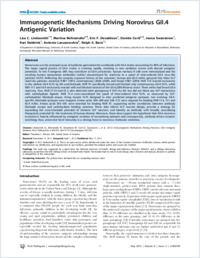Immunogenetic mechanisms driving norovirus GII.4 antigenic variation
- Lindesmith, Lisa C. Department of Epidemiology, University of North Carolina, Chapel Hill, North Carolina, United States of America
- Beltramello, Martina Institute for Research in Biomedicine (IRB), Faculty of Biomedical Sciences, Università della Svizzera italiana, Switzerland
- Donaldson, Eric F. Department of Epidemiology, University of North Carolina, Chapel Hill, North Carolina, United States of America
- Corti, Davide Institute for Research in Biomedicine (IRB), Faculty of Biomedical Sciences, Università della Svizzera italiana, Switzerland - Humabs Biomed SA, Bellinzona, Switzerland
- Swanstrom, Jesica Department of Epidemiology, University of North Carolina, Chapel Hill, North Carolina, United States of America
- Debbink, Kari Department of Epidemiology, University of North Carolina, Chapel Hill, North Carolina, United States of America
- Lanzavecchia, Antonio Institute for Research in Biomedicine (IRB), Faculty of Biomedical Sciences, Università della Svizzera italiana, Switzerland
- Baric, Ralph S. Department of Epidemiology, University of North Carolina, Chapel Hill, North Carolina, United States of America
-
17.05.2012
Published in:
- Plos pathogens. - 2012, vol. 8, no. 5, p. e1002705
English
Noroviruses are the principal cause of epidemic gastroenteritis worldwide with GII.4 strains accounting for 80% of infections. The major capsid protein of GII.4 strains is evolving rapidly, resulting in new epidemic strains with altered antigenic potentials. To test if antigenic drift may contribute to GII.4 persistence, human memory B cells were immortalized and the resulting human monoclonal antibodies (mAbs) characterized for reactivity to a panel of time-ordered GII.4 virus-like particles (VLPs). Reflecting the complex exposure history of the volunteer, human anti-GII.4 mAbs grouped into three VLP reactivity patterns; ancestral (1987–1997), contemporary (2004–2009), and broad (1987–2009). NVB 114 reacted exclusively to the earliest GII.4 VLPs by EIA and blockade. NVB 97 specifically bound and blocked only contemporary GII.4 VLPs, while NBV 111 and 43.9 exclusively reacted with and blocked variants of the GII.4.2006 Minerva strain. Three mAbs had broad GII.4 reactivity. Two, NVB 37.10 and 61.3, also detected other genogroup II VLPs by EIA but did not block any VLP interactions with carbohydrate ligands. NVB 71.4 cross-neutralized the panel of time-ordered GII.4 VLPs, as measured by VLP-carbohydrate blockade assays. Using mutant VLPs designed to alter predicted antigenic epitopes, two evolving, GII.4-specific, blockade epitopes were mapped. Amino acids 294–298 and 368–372 were required for binding NVB 114, 111 and 43.9 mAbs. Amino acids 393–395 were essential for binding NVB 97, supporting earlier correlations between antibody blockade escape and carbohydrate binding variation. These data inform VLP vaccine design, provide a strategy for expanding the cross-blockade potential of chimeric VLP vaccines, and identify an antibody with broadly neutralizing therapeutic potential for the treatment of human disease. Moreover, these data support the hypothesis that GII.4 norovirus evolution is heavily influenced by antigenic variation of neutralizing epitopes and consequently, antibody-driven receptor switching; thus, protective herd immunity is a driving force in norovirus molecular evolution.
- Language
-
- English
- Classification
- Medicine
- License
- Open access status
- gold
- Identifiers
-
- RERO DOC 326690
- DOI 10.1371/journal.ppat.1002705
- ARK ark:/12658/srd1319119
- Persistent URL
- https://n2t.net/ark:/12658/srd1319119
Statistics
Document views: 165
File downloads:
- Texte intégral: 203
